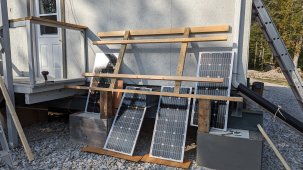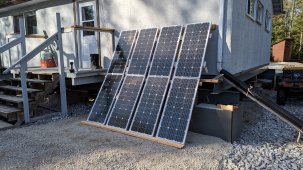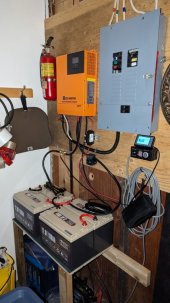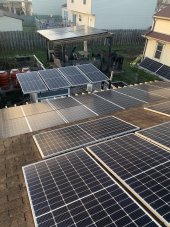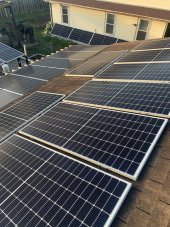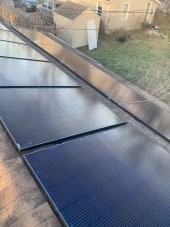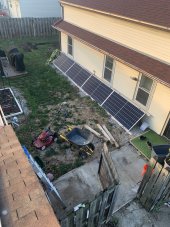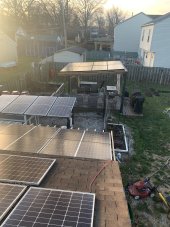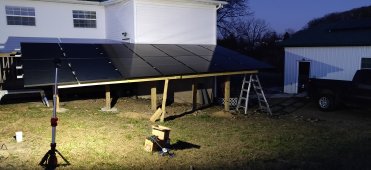You are using an out of date browser. It may not display this or other websites correctly.
You should upgrade or use an alternative browser.
You should upgrade or use an alternative browser.
Post your Ground Mount Setup
- Thread starter drps10
- Start date
at 45 degrees you'd need ~85 mph to blow them over. flat against the ground I didn't do calculations but it'd probably be like 400mph
yea that is a lot of shade, mine get sun hahaha
gotta move all my others over here, it is the sunniest area
Nobodybusiness
Collecting the leftovers of the Great Sky Reactor.
I did that once. Grass still hasn’t grown backhey guys OP says not to discuss the systems!
mine is the strongest mount, earth holds them

From my other area the grass hasn't grown back, but I don't want grass either lolI did that once. Grass still hasn’t grown back
but some other plants did, not sure their name.
They take over here I've been testing it. If I rip up grass they come up within 3 days. They're nice and deep green in the winter too.
Their seeds must be on every 1cm of the entire property they come up everywhere I take out other plants.
I did this in early 2017. Please post all critiques. Compliments not necessary. This is in Southern CA. the ground slopes both east to west and north to south. The ground is packed hard clay and granite with rocks and a crusty top of 2-4 inches. Very hard to work with to engineer.
Attachments
-
 mount 2-1.jpg359.1 KB · Views: 116
mount 2-1.jpg359.1 KB · Views: 116 -
 mount 3-1.jpg327.5 KB · Views: 101
mount 3-1.jpg327.5 KB · Views: 101 -
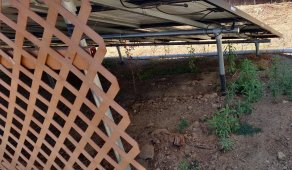 mount 4-1.jpg383.4 KB · Views: 90
mount 4-1.jpg383.4 KB · Views: 90 -
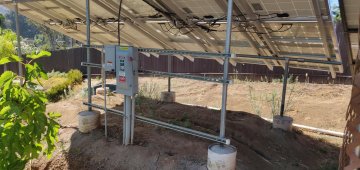 mount 5-1.jpg346.3 KB · Views: 86
mount 5-1.jpg346.3 KB · Views: 86 -
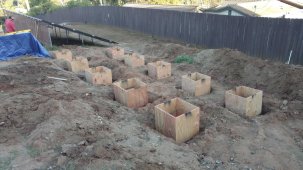 mount 7-1.jpg462 KB · Views: 83
mount 7-1.jpg462 KB · Views: 83 -
 mount 8-1.jpg515.8 KB · Views: 80
mount 8-1.jpg515.8 KB · Views: 80 -
 mount 10-1.jpg380.5 KB · Views: 81
mount 10-1.jpg380.5 KB · Views: 81 -
 mount 11-1.jpg553.9 KB · Views: 77
mount 11-1.jpg553.9 KB · Views: 77 -
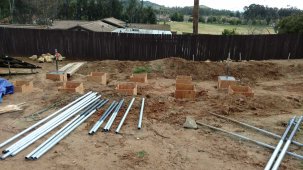 mount 12-1.jpg577.9 KB · Views: 75
mount 12-1.jpg577.9 KB · Views: 75 -
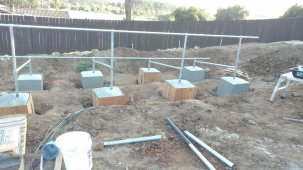 mount 13-1.jpg482.2 KB · Views: 87
mount 13-1.jpg482.2 KB · Views: 87 -
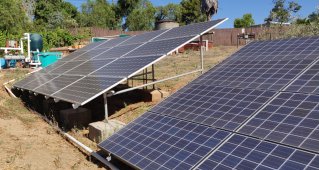 mount 1-1.jpg436.9 KB · Views: 115
mount 1-1.jpg436.9 KB · Views: 115
Hedges
I See Electromagnetic Fields!
- Joined
- Mar 28, 2020
- Messages
- 21,047
Mount 2-1, front to rear brace forms a rectangle and a triangle, subjecting rear upright to torsional loads.
I'd run that from top of front to bottom of rear, for all triangles.
Mount 3-1, no left-right diagonal braces.
I'd add a couple for earthquake resistance.
Mount 3-1, are those Delta LA-602 oil field "silicon varistor" lighting arrestors?






 diysolarforum.com
diysolarforum.com
(Be sure to watch Midnight's videos linked in post #4)
Mount 13-1, I see green wire.
Do you have a wire from PV frames back to chassis of SCC or inverter? If so, good!
Mount 1-1, are all panels oriented same?
I would have liked some strings oriented SE, some SW, for lower peak longer time of production (depending on usage.)
If net metering, best orientation depends on time of use rates.
I'd run that from top of front to bottom of rear, for all triangles.
Mount 3-1, no left-right diagonal braces.
I'd add a couple for earthquake resistance.
Mount 3-1, are those Delta LA-602 oil field "silicon varistor" lighting arrestors?

Delta LA 602 Lightning Arrestor "Hey! Is this thing on??"
I've been using Delta Lightning Arrestors on my system since they were spec'd by Real Goods as part of the package I bought from them. I now have a surge capacitor on the AC input as well, which is supposed to slow rising edge of voltage so it doesn't get as high before the Silicon Oxide...
(Be sure to watch Midnight's videos linked in post #4)
Mount 13-1, I see green wire.
Do you have a wire from PV frames back to chassis of SCC or inverter? If so, good!
Mount 1-1, are all panels oriented same?
I would have liked some strings oriented SE, some SW, for lower peak longer time of production (depending on usage.)
If net metering, best orientation depends on time of use rates.
When looking at mount 2-1 the camera perspective and angle of the ground alters the perspective of the phono and our eye. That cross brace is in fact not horizontal and no triangle is formed. It's an optical distortion.Mount 2-1, front to rear brace forms a rectangle and a triangle, subjecting rear upright to torsional loads.
I'd run that from top of front to bottom of rear, for all triangles.
Mount 3-1, no left-right diagonal braces.
I'd add a couple for earthquake resistance.
Mount 3-1, are those Delta LA-602 oil field "silicon varistor" lighting arrestors?


Delta LA 602 Lightning Arrestor "Hey! Is this thing on??"
I've been using Delta Lightning Arrestors on my system since they were spec'd by Real Goods as part of the package I bought from them. I now have a surge capacitor on the AC input as well, which is supposed to slow rising edge of voltage so it doesn't get as high before the Silicon Oxide...diysolarforum.com
(Be sure to watch Midnight's videos linked in post #4)
Mount 13-1, I see green wire.
Do you have a wire from PV frames back to chassis of SCC or inverter? If so, good!
Mount 1-1, are all panels oriented same?
I would have liked some strings oriented SE, some SW, for lower peak longer time of production (depending on usage.)
If net metering, best orientation depends on time of use rates.
Mount 3-1 left to right braces not required for wind loads in our locale. Mount design drawn by a solar engineer and permitted. Each concrete block weight is about 1100 pounds each. That's 6000 pounds of weight and the blocks are 24 x24 x 24 inches, about 10 inches into the ground to prevent sliding.
Yes, those are Delta lightening arrestors. I also have them mounted to Midnite Solar combiner boxes. We get maybe 4 lightening events a year hear and that would be a lot. I know about the Midnite LED, but that simply is not a concern worth the hundreds extra in this locale. But if I was back in Florida, I sure would spend the extra on Midnite arrestors.
All panels face south at 27 degree tilt. Remember, this was 2015-17 and nobody even knew much about net metering 2 let alone 3 and the changes. But yes, today, I would like a Southwest facing array too.
Mount 13-1 green wire: So at each array is a 10 foot grounding rod. Connected to the grounding rod is solid copper bare wire #8 I believe. This wire travels from the grounding rod and is bonded with UL approved ground connectors to each panel. the panels and their connections ground out to the array galvanized pipe and cross pieces. The grounding wire then connects into the Midnite Solar Combiner box which contains a grounding buss bar. The bare wire then completes the loop back to the ground rod, all uninterrupted. The green wire you see is connected to the combiner box buss bar. so is the Delta lightening arrestor ground connector. From the combiner box (which contains Midnite Solar 15 amp fuses for each parallel string, travels the PV +, PV- and the THHN green ground wire into PVC conduit. All of the arrays converge at a Schneider electric DC disconnect switch. The PV+ sides are solar fused across the blade switch, the negative PV passes through and the box is also grounded with a buss bar. This travels into the load center where the ground wire terminates on a buss bar that is also connected to two 10 foot grounding rods at that location connected by bare copper wire into that ground buss. So five grounding rods, 3 at arrays, 2 at the load center and inverter. From the buss bar, the PV wire passes thorough another DC breaker to the charge controllers which accept input as PV+, PV- and ground and output to the batteries as PV + and PV-. It's a little hard to write out, but it works.
Hedges
I See Electromagnetic Fields!
- Joined
- Mar 28, 2020
- Messages
- 21,047
When looking at mount 2-1 the camera perspective and angle of the ground alters the perspective of the phono and our eye. That cross brace is in fact not horizontal and no triangle is formed. It's an optical distortion.
OK, not a rectangle. Horizontal or slope, it is still a parallelogram. It resists wind pressure, and earthquakes, based on the torsional strength of the pipes.
My recommendation is to change connections to top & bottom of uprights, so it is entirely
Mount 3-1 left to right braces not required for wind loads in our locale. Mount design drawn by a solar engineer and permitted. Each concrete block weight is about 1100 pounds each. That's 6000 pounds of weight and the blocks are 24 x24 x 24 inches, about 10 inches into the ground to prevent sliding.
Maybe not for wind. Do you get earthquakes? My SWAG is 1g horizontally, and shaking repeatedly.
I have diagonal braces left/right.
Yes, those are Delta lightening arrestors. I also have them mounted to Midnite Solar combiner boxes. We get maybe 4 lightening events a year hear and that would be a lot. I know about the Midnite LED, but that simply is not a concern worth the hundreds extra in this locale. But if I was back in Florida, I sure would spend the extra on Midnite arrestors.
Have you looked at the voltage clamping curves published by Delta?
I have absolutely no reason to believe them. On a whim I tested mine, and found it held off 5000Vrms (about 7000Vpeak) without clamping.
I contacted Midnight, who's engineers are about the most respected and have been around the longest of anyone in the alternative energy industry. They just replied wryly, "Cut the end off and pour the sand out."
"Silicon Dioxide Varistor" my @$$!
Watch Midnight's videos. Absolutely nothing happened. Until cranked up to 50,000V, and then they blew apart.
I didn't want to spend the hundred fifty bucks either.
Some of my inverters have MOV installed on PV lines, but not all. I ordered more from Digikey.
For the AC side I was going to build one similar to Midnights, but ended up getting an unused industrial one for the same $150 price.

Testing Metal-Oxide Varistors (MOV)
Surge arrestors are used on AC and DC side of PV inverters for protection, to clamp high voltage transients. One inverter I have (actually several) are in the SMA family SUNNY BOY 5000-US / 6000-US / 7000-US / 8000-US. These come with a kit of MOV to protect the DC side: The MOVs are about...
All panels face south at 27 degree tilt. Remember, this was 2015-17 and nobody even knew much about net metering 2 let alone 3 and the changes. But yes, today, I would like a Southwest facing array too.
yeah, mine is aimed South West, was all one orientation. Based on time of use in 2003 (Noon to 6:00 PM.)
Now that peak is 4:00 to 9:00 PM, I've added about 33% more aimed almost due West.
Mount 13-1 green wire: So at each array is a 10 foot grounding rod. Connected to the grounding rod is solid copper bare wire #8 I believe. This wire travels from the grounding rod and is bonded with UL approved ground connectors to each panel. the panels and their connections ground out to the array galvanized pipe and cross pieces. The grounding wire then connects into the Midnite Solar Combiner box which contains a grounding buss bar. The bare wire then completes the loop back to the ground rod, all uninterrupted. The green wire you see is connected to the combiner box buss bar. so is the Delta lightening arrestor ground connector. From the combiner box (which contains Midnite Solar 15 amp fuses for each parallel string, travels the PV +, PV- and the THHN green ground wire into PVC conduit. All of the arrays converge at a Schneider electric DC disconnect switch. The PV+ sides are solar fused across the blade switch, the negative PV passes through and the box is also grounded with a buss bar. This travels into the load center where the ground wire terminates on a buss bar that is also connected to two 10 foot grounding rods at that location connected by bare copper wire into that ground buss. So five grounding rods, 3 at arrays, 2 at the load center and inverter. From the buss bar, the PV wire passes thorough another DC breaker to the charge controllers which accept input as PV+, PV- and ground and output to the batteries as PV + and PV-. It's a little hard to write out, but it works.
I understand a bunch of ground rods, but it wasn't clear to me the network of conductors for ground go all the way back to chassis of inverter (or SCC).
''where the ground wire terminates on a buss bar that is also connected to two 10 foot grounding rods at that location" makes it sound like it stops short of the inverter.
That is the primary thing I'm concerned with. Wire from inverter to PV panel frames ensures fault current, in the event of a short to PV frame, gets back to inverter without having to go through dirt (or people.) Also, some inverters drive AC onto PV+/-, and people have gotten shocks off the frames, until they completed the circuit with a wire.
Last edited:
Fisherguy66
New Member
Pinto Yates
About 2 steps from off-grid
I’ll have to take one and post it. It’s just unistrut and wood with some WIP. (Wiring In Progress). I’m not 100% satisfied with the design yet and may add on more to improve integrity. My engineer buddy saw it, rolled his eyes, and mumbled something about four points of contact.Do you have a picture of the back? Would like to see how everything is fastened together. It looks very clean from the front.
The ground mount using the concrete blocks are connected in an uneven quadrangle format. ALL of California is in an earthquake zone. The engineering design met code and there is no habitable structure near it so I guess if it collapses, no one gets hurt. The structure is schedule 40 2 inch galvanized pipe and Hollaender connections. The rails are Prosolar. The design concern for permitting was mainly concerned with wind loading, proper grounding, heights, trench depths and wire gauges. Earthquake not at all since there are always tremors here, just not the big one. As for the Delta lightening arrestors, they are mainly cosmetic here as we just don't get lightening. I am not endorsing them or advising on them.
Regarding the grounding rods. Each array has a ground rod pounded in at the array. the inverter and attached equipment plus load centers and breaker boxes are connected to ground by two grounding rods, spaced 10 feet apart, in the ground just on the other side of the garage wall. This ground wire enters through garage wall and is connected to a large ground buss bar in a load center where it then grounds the inverter, batteries, sub-panels, conduits as well as makes the connection with the ground wire out to the arrays.
Regarding the grounding rods. Each array has a ground rod pounded in at the array. the inverter and attached equipment plus load centers and breaker boxes are connected to ground by two grounding rods, spaced 10 feet apart, in the ground just on the other side of the garage wall. This ground wire enters through garage wall and is connected to a large ground buss bar in a load center where it then grounds the inverter, batteries, sub-panels, conduits as well as makes the connection with the ground wire out to the arrays.
@prepared_life
Newbie to Solar here for Knowledge
So besides the garage not being a ground mount, technically the rest is. Built a pergola this summer with 8 panels atop, put 4 on the coop, 4 behind the house, and built an extension onto the garage to house 8 panels. On the garage sets 18 panels for a total of 42 which is probably my max, as I will not put any on the house.
Attachments
42OhmsPA
What's in a title?
Kenny_
Solar Addict
Veeeraa Nice!!
I'm kinda thinking of something like that for my more permanent setup...when/if I ever get there...
and or doing something with my rear patio roof/cover that needs replacing anyway...
I'm kinda thinking of something like that for my more permanent setup...when/if I ever get there...
and or doing something with my rear patio roof/cover that needs replacing anyway...
Hedges
I See Electromagnetic Fields!
- Joined
- Mar 28, 2020
- Messages
- 21,047
Upgraded from 12 305w panels to 14 370w...
Will finish things up in the morning.
View attachment 183200
Are you powering those lights from the solar panels the lights shine on?
(How much electricity can we generate by campfire light?)
42OhmsPA
What's in a title?
? The battery in the light was in fact charged via the old LG Neon's. I have been tempted to throw a 100w panel under some grow lights for experimentation.Are you powering those lights from the solar panels the lights shine on?
How many Peltier modules are we using and what kind of temperature gradients are we working with?(How much electricity can we generate by campfire light?)
Hedges
I See Electromagnetic Fields!
- Joined
- Mar 28, 2020
- Messages
- 21,047
Co-generation. The light falls on PV panels, and the hot exhaust goes through chimney with Peltier to heat water.
I guess we could recycle old batteries by burning the lithium. Although I think magnesium may provide better spectrum.
I guess we could recycle old batteries by burning the lithium. Although I think magnesium may provide better spectrum.
ruralsolar
New Member
42OhmsPA
What's in a title?
Very nice! Any photos from the back?Hopefully it doesn't snow much. Need some dirt digging equipment to make some room for snow shedding
View attachment 183254
Similar threads
- Replies
- 5
- Views
- 501
- Replies
- 1
- Views
- 372
- Replies
- 29
- Views
- 903




